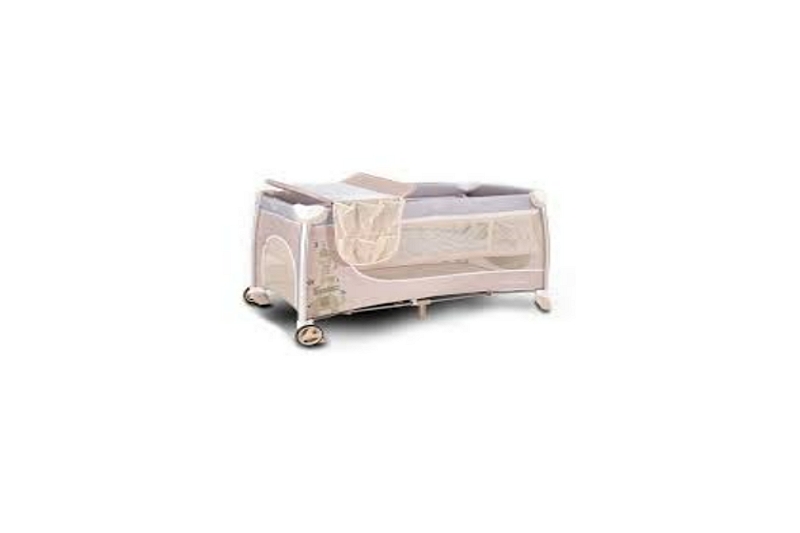How to keep toddler playpen from sliding? There are a few ways to keep toddler playpen from sliding on the floor.
Most commonly, parents use rug grip tape or other self-adhesive tapes as well as double-sided adhesive squares to make sure their children cannot slide around within the pen.

Additionally, some choose to install drawer slides under each corner of their child’s playpen so that it does not move at all no matter how much they push and pull against it.
Another common solution is using cups filled with sand underneath each corner of your child’s crib/playpen because this works similarly to installing drawer slides – except for a significantly cheaper price tag!
This method may also be used in conjunction with any other non-permanent option if you prefer only one small corner to have a cup of sand underneath it.
Rug grip tape or self-adhesive double-sided adhesive squares are used as well as cups filled with sand under each corner of the pen. Additionally, some choose to install drawer slides under each corner of their child’s playpen so that it does not move at all no matter how much they push and pull against it.
Another common solution is using cups filled with sand underneath each corner of your child’s crib/playpen because this works similarly to installing drawer slides – except for a significantly cheaper price tag!
This method may also be used in conjunction with any other non-permanent option if you prefer only one small corner to have a cup of sand underneath it.
What do you use a playpen for?
There are many uses for playpens. The playpen can be used in the following ways:
-As a safe place to put your baby when you need hands free time, such as when working with housework or cooking dinner. They’re also great for keeping little ones occupied while watching TV and playing video games too!
-To keep them isolated from other pets (such as cats and dogs) that might otherwise injure them during rough play sessions. It is advised to get a separate “kitty condo” if you have cats who like high perches so they don’t jump down on top of the babies inside their pens; very dangerous…especially since kitties always land feet first!
-To take with you when travelling or to use in hotels. This helps keep your baby safe, secure and comfortable during their travels too! They can either be used as a play space for older babies who are sitting up front playing safely around the floor; which is safer than crawling out into traffic at that age!
Or they can also provide an enclosed “contained” area where younger infants can sleep soundly without being disturbed by other people coming and going throughout the room.
There are now even playpen/playard combos available so parents don’t have to buy two separate items but instead just one product made specifically for both purposes….wow what convenience!
At what age do you stop using a playpen?
While it is not recommended to use a playpen after the age of two, many parents find that they can continue using them for their toddlers well into preschool and even kindergarten.
This allows your child to have an independent space where he or she feels comfortable playing while you’re still insight. On top of this, some kids prefer staying in their playpens as they transition from babyhood into childhood because it helps them feel more secure and safe when left alone at times.
As long as there are no safety concerns with your particular playpen and you don’t mind continuing its use, then by all means do so!
It may be hard leaving your little one behind once he or she has become accustomed to spending time within the familiar confines of his or her playpen, but this is a great way to train your child how to be alone and independent.
Is it OK to keep a toddler in a playpen?
Not only is it OK to keep a toddler in a playpen but it can be very beneficial. A child’s temperament, behaviour and age all influence the type of containment you choose for your little one.
Playpens are an essential tool when caring for children because they help us feel secure that our kids are safe while allowing room to roam without necessarily having them under constant supervision or control.
The American Academy of Pediatrics recommends using confinement as part of responsible caregiving so long as there aren’t any safety risks associated with its use (such as possible entanglement). Using these guidelines will ensure happy parents and caregivers!
How do you turn a pack and Play into a toddler bed?
First, you have to get a pack and play. I recommend the Graco Pack ‘n Play because it has adjustable heights for when your baby is very young or older.
It also converts into two separate beds instead of just one big bed. This makes transitioning from co-sleeping easier down the road if that’s something you want to do (which we did).
Next, purchase a mattress like this one. We got our memory foam mattress on Amazon and only paid $50! You don’t need any special sheets; we used regular crib size ones until he was ready for toddler-sized sheets at 18 months old. Then we found these waterproof sheet protectors, which are great because they keep his mattress protected from accidents and also keep it clean.
But the most important part of converting a pack and play into a toddler bed is buying this Playard Mattress Pad. This keeps your child safe by keeping them on their mattress instead of out in the open, which can be very dangerous for young toddlers who are just learning to walk or even crawl!
Just make sure you buy one that fits exactly within the dimensions of your pack and play so there are no gaps where they could get stuck.
